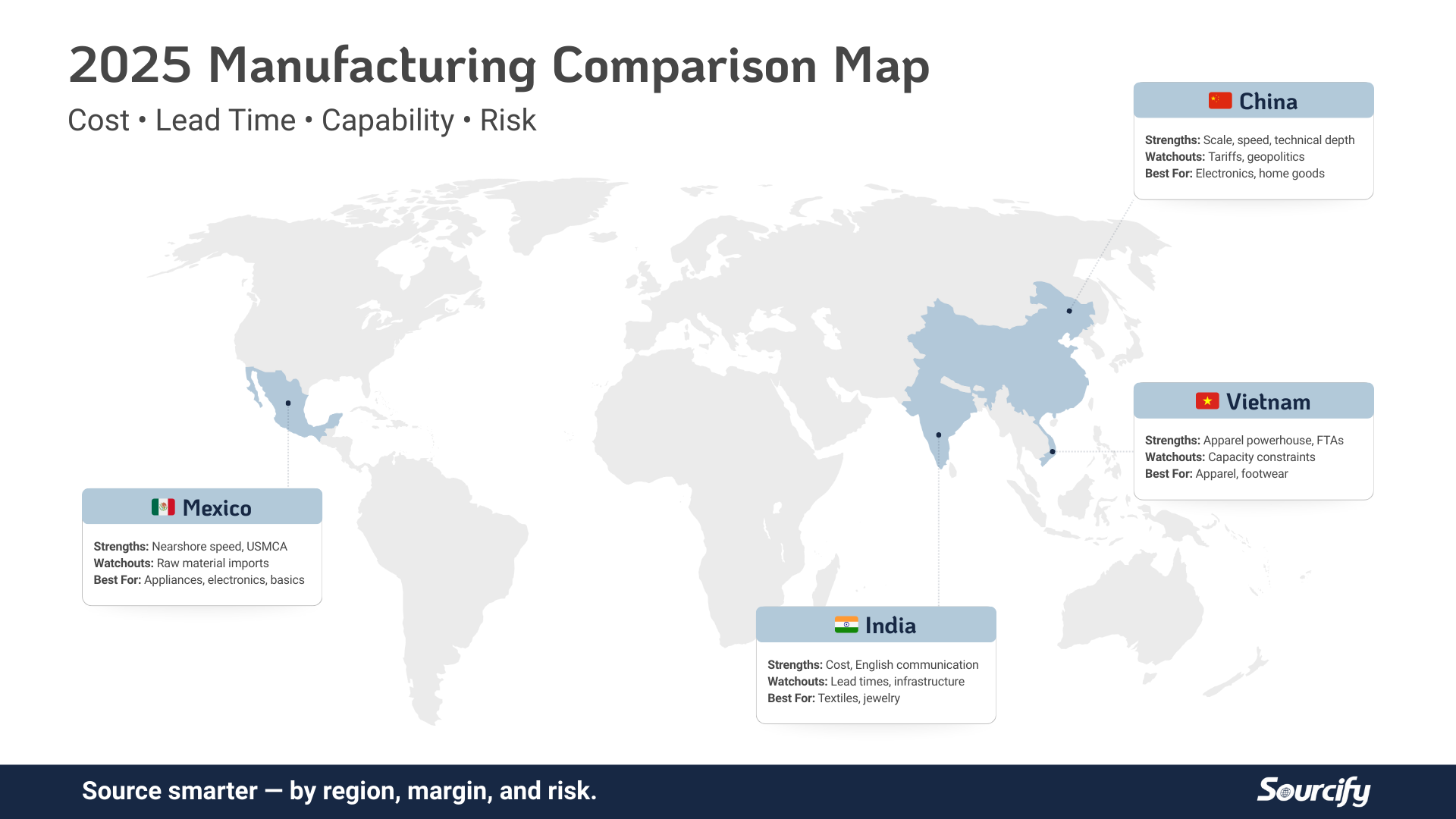Could you be cheating yourself?
There’s a good chance that you could be making more money than you are right now—without raising your prices for the end user. You can make your margins go up, your cost of goods sold go down, and your profits increase—and it’s not nearly as hard as you think.
How? By taking advantage of overseas sourcing.
I’ve had the opportunity to put this into practice both for my own businesses and for other people’s. Sourcify is built on this concept. And you can do it too. Here are 4 ways you can improve your COGS and margins with overseas sourcing.
1) Take Advantage of Lower Labor Costs
Though costs for manufacturing overseas are going up, they’re not nearly as high as they are domestically still. In China in particular, labor costs are one of the things driving a lower cost for manufacturing.
There’s an ethical line to be checked—you don’t want to wind up partnered with an exploitative manufacturer—but doing good vetting beforehand or partnering with a company like Sourcify that does the vetting for you can avoid that.
From 1987 to 2016, unit labor costs in the United States have risen in 79 of 90 manufacturing industries. Many of those industries have seen slowdowns in productivity combined with boosts in manufacturing costs.
Some of that is beneficial—higher safety standards and wages that keep up with cost of living in manufacturing areas—but it’s an undeniable trend that United States manufacturing has traditionally been more expensive. And it doesn’t look like that trend is changing.
Going overseas for manufacturing can open you up to different labor pools, and sometimes labor pools that tend to be more skilled in that particular field—textiles are one such field that usually has a much larger labor pool overseas than stateside, and there are more. More skilled workers can keep costs down.
2) Take Advantage of Access to Raw Materials
Raw materials are another cost that can drive up your COGS and decrease your margins. Depending on what you’re trying to manufacture, it may be easier to find the raw materials overseas.
For example, rare earth metals being sourced from China—if you’re using rare earth metals in your manufacturing, the cost of transportation would be less because they’re not having to travel as far.
Sometimes the location of the labor pool and the location of the raw materials in relation to each other can be a factor, too. Proximity lowers prices, and when your workers are close to the material and the factory, you’re minimizing transportation costs and maximizing the pool of skilled labor.
They work in tandem.
3) Take Advantage of Lower Taxes, Tariffs and Duties
This will vary based on your industry and the raw materials you’re using, but some nations can produce goods more cheaply simply because their taxes are lower.
European chemical manufacturers, for example, can take advantage of zero or low import duties on oil and naphtha. Don’t just rely on one quote from a local manufacturer. Learn the tariffs and taxes, and you might be able to capitalize on it.
An example of this might be polyethylene resin, which for a long time was much more expensive in the United States than overseas. There were fewer producers in the United States than overseas, and the countries that produced this resin limited the supply that was available overseas. This forced companies to go overseas for their production or face higher production costs.
If your raw materials are subject to limited supply to the manufacturer or higher duties, you may want to look closer to the source, or at a country that’s trying to incentivize production of goods made from that raw material. You might find that your COGS goes down.
One caveat to this: sometimes you might have to go overseas despite tariffs. For example, 98% of American footwear (as of 2016) was manufactured overseas, despite heavy tariffs averaging around 20% of the cost of the shoes. That’s because the manufacturing base is mostly overseas—American factories for footwear are rare. Sourcing locally may or may not be an option.
4) Take Advantage of Suppliers’ Resources
If you’re limiting yourself to only domestic manufacturers, you might be ignoring an easy way to cut costs: using molds or patterns that already exist. I ran into this with the second round of designs with my old company, Yes Man.
We used a slightly more generic design for the watch case, which allowed us to use a mold that already existed. Our manufacturer had the exact watch case mold that we were looking for, saving us thousands of dollars in production costs.
This also saves time at the start of the process, which can help you get your goods to market quicker and lower your COGS.
Another benefit is that often if the molds already exist, the manufacturer already has experience with similar production runs, which can cut down on time and costs. If they’re already used to doing the work that you’re asking them to do, you’re reducing friction and thereby reducing your manufacturing costs.
This isn’t just limited to overseas companies, of course. You might find that there’s a domestic factory that’s already done the legwork, or you might find it’s an overseas factory.
Don’t geographically limit yourself in which manufacturers you look at, though, because if you can find a company that’s already done the work, you’re going to save yourself a boatload.
Margin Benefits Aren’t Marginal
If you’ve been in business for any length of time, you’re aware how much of a difference even small changes can make. Domestic manufacturing is great, but if you’ve been limiting yourself to that, are you cheating yourself out of the opportunity for better margins and a healthier-looking COGS number at the end of the year?
Don’t neglect overseas manufacturing. It just might offer the competitive advantage you need to gain an edge in today’s highly competitive global marketplace.




